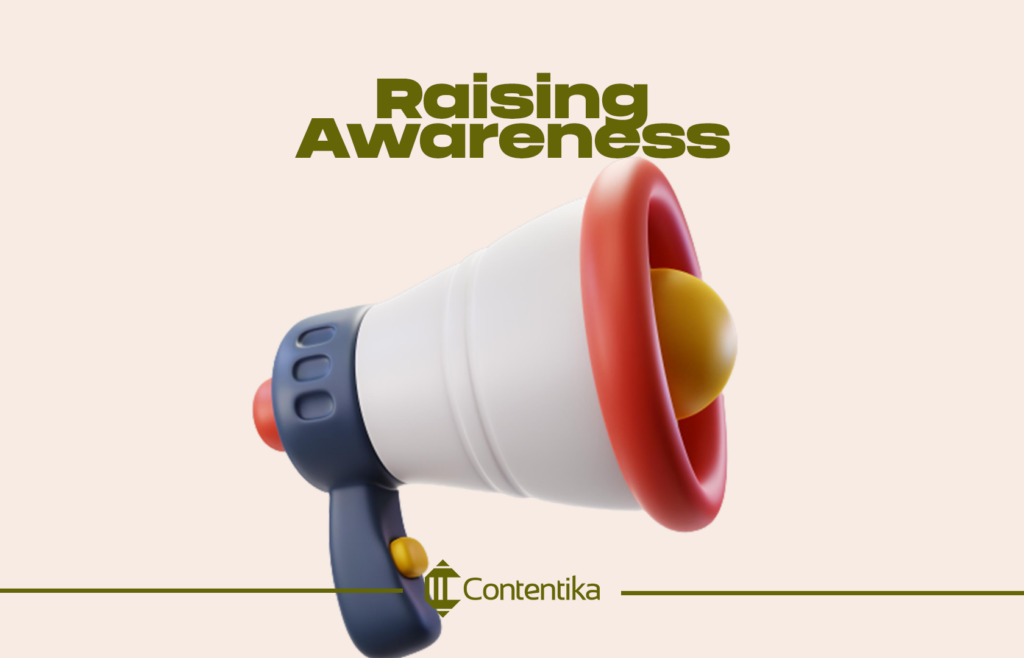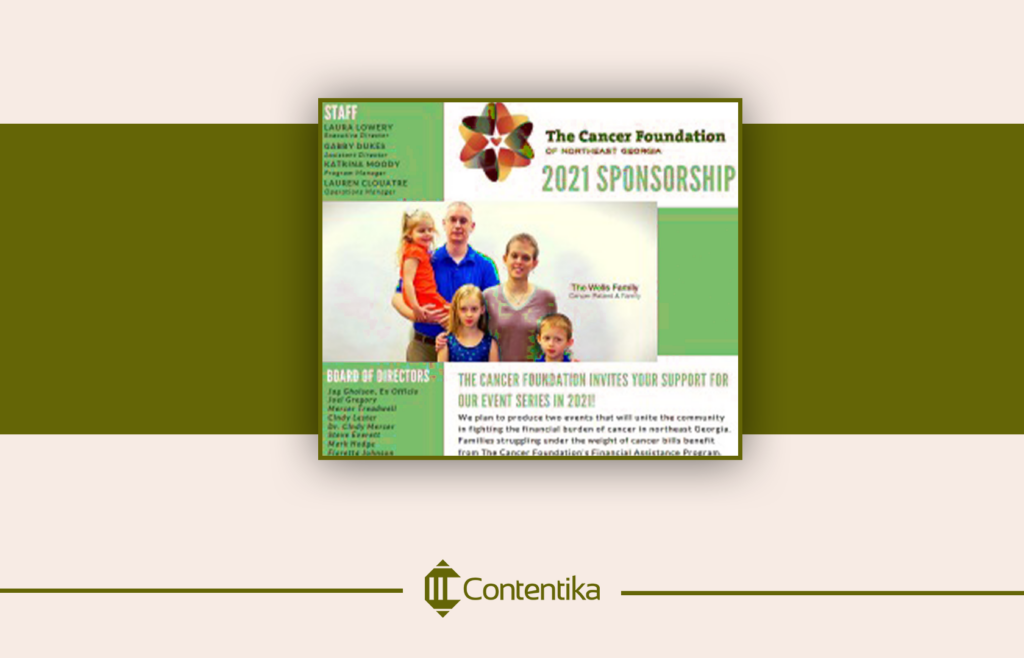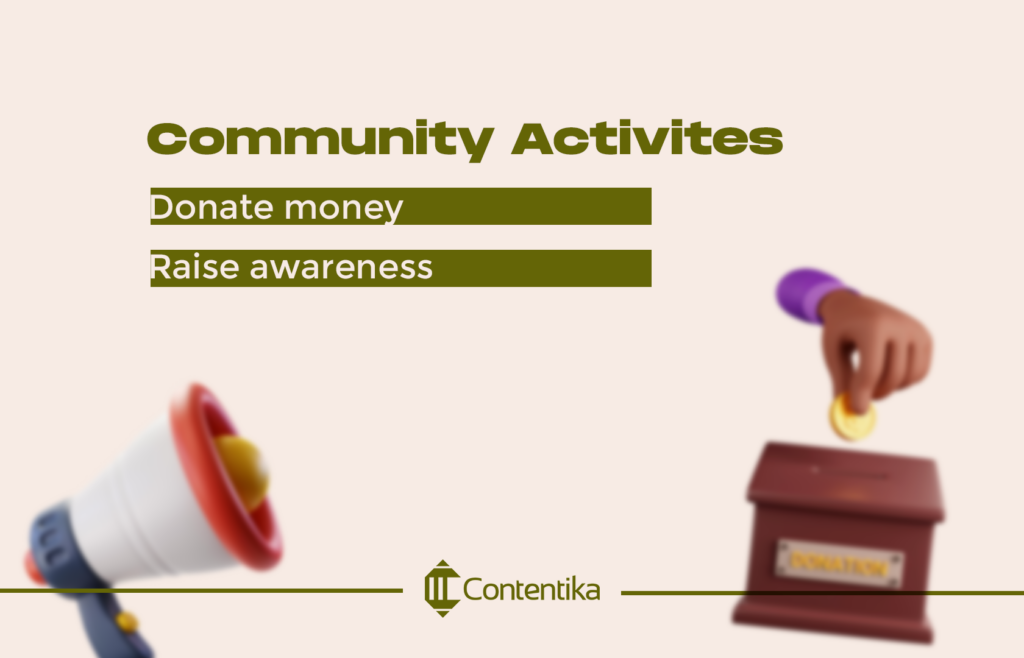With the increase in spiritual and social awareness toward purposeful living, the non-profit sector is growing exponentially. The global nonprofit organizations market accounted for $264.73 billion in 2021.
Non-profit organizations perform a crucial role in overall societal development. The sector plays a significant role in addressing social and environmental issues and improving the quality of life for communities around the world.
However, with the growth of non-profits comes increased competition for attention, resources, and support. In a world where attention is a commodity, non-profits must effectively communicate their mission and impact to attract support from potential donors and volunteers. So how can your non-profit stand out in the crowded landscape and effectively communicate its message to the world?
The answer lies in innovative marketing for nonprofits. By thinking outside the box and utilizing creative tactics, your non-profit can make a significant impact and attract the support it needs to succeed. This blog post will explore the importance of marketing non-profit and provide tips and examples to help you get started.
What Is Non-profit Marketing?
Nonprofit marketing refers to the use of marketing strategies and tactics by nonprofit organizations to promote their cause, engage with their target audience, and raise awareness and funds for their mission.
The goal of nonprofit marketing is to effectively communicate the organization’s message, values, and objectives and to inspire action from potential supporters, donors, volunteers, and advocates.
Nonprofit marketing often involves a variety of channels, including digital media, print materials, events, and personal outreach. Nonprofits must choose their marketing efforts carefully, as they often have limited resources and need to maximize the impact of every dollar spent.
How Does Non-profit Marketing Work?
The ultimate aim of nonprofit marketing is to promote the nonprofit organization’s cause. This could result in either increased awareness of the organization’s mission, increased funds from existing donors and new donors, more volunteers and foot soldiers for campaigns, or a combination of these outcomes. Nonprofit marketing involves using various marketing techniques and strategies to reach and engage with potential supporters, stakeholders, and the general public.
This can involve a combination of content marketing, traditional marketing, event marketing, and social media marketing. For example, a non-profit organization may create and share educational articles, videos, and infographics about its cause to raise awareness and educate the public.
They may also host fundraising events, such as charity runs or auctions, to raise funds for their cause. They may use platforms like Facebook, Twitter, and Instagram to engage with their followers and share updates on their programs and initiatives. Additionally, they may use influencer marketing to partner with individuals or organizations with a large following to help spread the word about their cause.
Another critical aspect of non-profit marketing is cultivating and building relationships with potential supporters. They can do this by creating personalized communication and messaging, responding to inquiries and feedback, and offering opportunities for people to get involved and support the cause.
In summary, nonprofit marketing is about effectively communicating the mission and impact of the organization to attract support and build a dedicated community of supporters. It requires a strategic and integrated approach that considers the target audience, the goals of the organization, and the resources available.
Importance of Non-profit Marketing
If non-profit organizations are not trying to make sales or make profits, why is it important for them to take their marketing seriously? Below are some of the reasons why non-profit marketing is so important:
Raising Awareness

Nonprofit marketing is crucial for raising awareness about the organization’s cause and mission. This can help the organization reach a wider audience, attract more supporters, and increase public understanding of the issue they are trying to address.
Regardless of the cause a non-profit organization is trying to push, members of the public, or at least those affected by the issue they are trying to promote, must have crucial knowledge passed on to them by the organization.
Attracting Donors and Volunteers

Since non-profits do not have a business generating profits, they have to rely on donor funding. They also have to rely on human resources from volunteers to perform administrative tasks and garner support for their campaigns.
Nonprofit marketing can be used to recruit volunteers and build a community of supporters who are committed to the cause. Through marketing campaigns and events, non-profits can inspire people to get involved and contribute their skills and time to make a difference.
Building a Strong Brand

Nonprofit marketing can help organizations build a strong brand that accurately represents their values and mission. By creating a consistent image and message, non-profits can differentiate themselves from other organizations and establish a recognizable and trusted presence in the community.
By building a strong and appealing brand, non-profits can drive political and social change. People are more likely to connect with a nonprofit with a strong brand presence. For example, the American Cancer Society has a well-established brand that is easily recognizable and inspires trust among its supporters.
Demonstrating Impact and Enhancing Partnerships

Nonprofit marketing can be used to demonstrate the impact of the nonprofit organization and show the positive results of its work. This can build public trust and support for the cause and attract more resources for the organization.
Organizations can also develop partnerships with other organizations, businesses, and individuals who share their mission through non-profit marketing. By working together, non-profits can achieve more.
Improving Decision-Making

Effective non-profit marketing can provide valuable insights into the needs and attitudes of the target audience, which can help a nonprofit organization make informed decisions about its programs and initiatives and tailor their marketing efforts to reach and engage with its target audience effectively.
By gathering information and data through marketing efforts, non-profits can gain a deeper understanding of their target audience and what motivates them to support the cause.
For example, a non-profit organization may use surveys or focus groups to gather information about the attitudes and preferences of its target audience. This data can then be used to make informed decisions about the types of programs and initiatives to implement, the messaging and tone to use in marketing materials, and the types of events and activities to organize.
Types of Non-profit Marketing
Point-of-Sale Marketing

Point-of-sale (POS) non-profit marketing refers to a fundraising effort that occurs at the point of sale or when a customer is making a purchase. The goal of POS non-profit marketing is to encourage customers to donate to a non-profit organization or cause at the time of their purchase.
There are several ways that point-of-sale non-profit marketing can be implemented. Some include:
- Round-up campaigns: This involves asking customers to round up their purchase total to the nearest dollar and donate the difference to the non-profit organization. This is a simple and easy way for customers to donate and support the cause.
- Checkout Donation Programs: This involves partnering with retailers and businesses to allow customers to donate at their checkout. This can be a powerful way to reach a large audience and raise funds for the cause.
- Product Donations: This involves partnering with for-profit companies and businesses to donate a portion of the sales of specific products to the non-profit organization. This can be a great way to raise awareness about the cause and generate funds.
Message-Focused Campaign
A message-focused campaign is a marketing or advertising effort centered around a specific message or theme. It aims to communicate a specific message to a targeted audience and make an impact or evoke a response.
In such campaigns, the message is the most crucial aspect and is carefully crafted to resonate with the target audience. The campaign’s marketing materials, such as advertisements, social media posts, and other content, all support and reinforce the central message.
Message-focused campaigns can be used for various purposes, such as promoting a new solution or way of life, raising awareness about an issue, or building brand recognition. They can be tailored to reach different audiences through various channels, such as television, print, digital, and social media.
Transactional Campaign
A transactional campaign is a marketing effort focused on generating a specific action or transaction from the target audience, such as making a purchase, signing up for a service, or filling out a form. The goal of a transactional campaign is to drive immediate, quantifiable results.
In a transactional campaign, the messaging and marketing materials are designed to be highly persuasive and to communicate the value of making a purchase. For example, a non-profit that works on putting kids in school could launch a transactional campaign selling branded materials that carry the organization’s message, with the funds going into promoting the organization’s cause.
A non-profit can also execute a transactional campaign by partnering with a business organization as a corporate donor and encouraging consumers to use their purchases to help fund the nonprofit’s charitable efforts. The corporate donor benefits from the positive publicity, and the nonprofit gets funds to pursue its goals.
These campaigns often use targeted, data-driven tactics, such as email marketing, display advertising, and retargeting, to reach the target donors and drive conversions. The success of a transactional campaign is measured by the number of transactions or actions generated and the return on investment for the campaign.
Traditional Fundraising
Traditional fundraising refers to the practice of raising money for a nonprofit organization through the use of established methods and channels. These methods often include door-to-door canvassing, direct mail, telemarketing, and in-person events such as charity galas and auctions.
Traditional fundraising relies on face-to-face interactions, personal connections, and emotional appeals to generate support and donations from individuals, corporations, and other organizations. The focus is often on building relationships with donors and cultivating their loyalty over time.
Traditional Media Marketing
Traditional media marketing refers to using media channels, such as television, radio, print, and out-of-home advertising, to reach target donors and communicate a marketing message.
A nonprofit can create impactful and memorable ad content that captures the target audience’s attention and effectively communicates the marketing message using eye-catching visuals, attention-grabbing headlines, and creative storytelling.
Non-profit Marketing Issues
Nonprofit organizations face unique challenges in marketing and promoting their cause. Some of the issues that nonprofit organizations commonly face in marketing include:
Limited Resources
Many nonprofits have limited budgets and staffing, which can make it difficult to reach and engage their target audience effectively. Unlike business organizations, nonprofits do not have ready access to funds and often have to choose between spending available funds on the organization’s mission or marketing.
Competition for Attention
The nonprofit sector is growing exponentially, and there is increased awareness of social issues. This means that more than ever, more nonprofit organizations are competing for donor funding and attention in a crowded and competitive landscape.
Difficulty in Measuring Impact
Businesses can easily measure the success of their marketing efforts using various metrics and analytic tools. However, it can be challenging to quantify the impact of a nonprofit’s marketing efforts and to measure the return on investment for a campaign.
Balancing Mission and Marketing
Nonprofits must find a balance between promoting their cause and their brand while also being mindful of how the public perceives their marketing efforts. Overly aggressive or misleading marketing can harm the organization’s reputation and detract from its overall mission.
Demonstrating Impact and Building Trust
Nonprofits must be able to effectively communicate the impact of their work to potential donors and supporters in a way that resonates and inspires them to take action. They must also build and maintain trust with their audience, particularly in managing and using donor funds. This is tricky in the nonprofit space, as consumers expect more.
How To Create a Non-profit Marketing Plan
There are more and more issues demanding our attention today. This is the price we pay for knowledge and awareness. As more and more people get into the development and social justice sector, the pressure on nonprofits to stand out in their marketing efforts has never been more.
Here are some tips to help you develop a marketing plan that will drive donors and volunteers your way:
Have a Goal
The best way to create a workable plan for your nonprofit marketing is to have a clear, measurable goal. Be clear on the number of donors you want to attract, the amount of money you wish to raise, or the number of volunteers you need to engage. A specific goal in mind will help you stay focused and make informed decisions about your marketing strategies.
Develop a Clear Message
No one says you can only stick to one cause as an organization. However, you must ensure consistency in every message you put out as an organization. You must avoid confusing potential donors and volunteers with contradictory statements.
Have a Budget
You must be clear on the percentage of your funds you want to spend on marketing. A marketing budget that is too lean will reflect on the amount of money you raise for your organization.
On the flip side, you don’t want to spend more money than is necessary on marketing when you could be using the funds to drive the aim of your organization. Finding the right balance is critical.
Know Your Donors
Before you start planning your marketing strategy, you must understand your target audience. What are their demographics, interests, and values? What motivates them to get involved with your organization? Understanding your audience will help you tailor your message and reach them more effectively.
Form Connections Using Storytelling and Visuals
People are more likely to fund your nonprofit or join you in your campaigns if they can relate to whatever it is you are promoting. One way to create a connection between your organization and your target audience is to use storytelling marketing.
Storytelling can increase conversions.

Especially when you utilize visuals in your storytelling. Also, visual content such as videos can increase your brand recognition by up to 95%. Combining these two marketing tactics can bring about phenomenal results for your nonprofit.
Segment and Choose Your Channels
As a nonprofit, you must recognize that your ideal donor can come from within any demography or social group. Hence, you must segment your communications to resonate with each audience block.
Also, only some marketing channels will be suitable for all donors. For example, strong social media campaigns make you more likely to capture Gen Zers as donors or volunteers.
On the other hand, email marketing and traditional fundraising might be more appropriate if you are targeting corporate donors.
Prioritize Donor Privacy
Donor privacy is an essential issue in philanthropy and fundraising efforts. Ensuring the privacy and confidentiality of donors is vital in building trust and maintaining the integrity of the organization.
Appeal to Emotions, Don’t Overpromise
Nonprofits often work in areas that evoke strong emotions, such as poverty, illness, or environmental issues. By tapping into these emotions, organizations can connect with their audience and motivate them to take action.
However, it is essential to avoid overpromising or making false or exaggerated claims is essential. This can erode trust and damage the reputation of the organization. Instead, be transparent and honest about the impact that can be achieved through a donation or volunteer effort.
Highlight the positive changes that have been made in the past and provide clear, tangible examples of what a donation or volunteer effort can achieve.
Show Your Workings
Showing your workings refers to being transparent and open about the inner operations of your organization. This includes sharing information about how donations are used, their impact, and the results of your work.
By doing this, you can build trust and credibility with your supporters and demonstrate your accountability and effectiveness.
You can become more transparent as a nonprofit by sharing progress reports of your work and releasing necessary documentation to sponsors, such as your accounts for a fiscal year, event reports, etc. You can also ensure that members of your team are well-known and that their contributions to the organization are clearly stated.
Prioritize SEO and Mobile-Responsiveness
Optimizing your website for search engines can increase your organization’s visibility and reach a wider audience. This involves using keywords, meta descriptions, and other techniques to make your website more appealing to search engines and improve your search engine rankings.
Also, with the increased use of smartphones and mobile devices, it’s essential to ensure that your website is mobile-friendly and easily accessible to mobile users. A mobile-responsive website improves the user experience and positively impacts your search engine marketing.
Create a Unique Presence and Brand
Creating a unique presence and brand is crucial for nonprofits to stand out in a crowded field and attract more support. A strong brand should reflect the nonprofit’s mission, values, and goals and communicate them in a consistent and memorable way.
This includes creating a distinctive logo, tagline, and visual identity and establishing a consistent tone of voice in all communication materials. It is important to research and gain a deep understanding of your target audience to develop a brand that resonates with them.
Follow Up
Following up with supporters is an important part of any nonprofit marketing plan. By staying in touch and providing ongoing support, organizations can deepen their relationships with their supporters and lapsed donors, increase retention, and attract new supporters.
There are different ways to follow up with your audience, including sending out thank you notes or emails, sending reminders for upcoming events, sending helpful updates, and asking for feedback. However, you must be careful not to spam your audience; you don’t want to piss off potential donors with incessant messages.
Measure and Evaluate
Measurement and evaluation are crucial components of any nonprofit marketing plan. By setting clear goals and tracking metrics such as website traffic, conversion rates, and feedback from supporters, organizations can gain a deeper understanding of the impact of their marketing efforts.
Regular analysis of the results allows for informed decision-making, adjustments to the marketing plan, and other improvements to achieve better results. These help to optimize the marketing approach and helps organizations make the most of their resources and attract more support for their cause.
Marketing Strategies for Non-profit Organizations
Nonprofit organizations face unique challenges in their marketing efforts, but several strategies can help them effectively reach their target audience and attract support. Here are some of the most effective marketing strategies for nonprofits:
Email Marketing

Email marketing is a powerful tool for nonprofit organizations to reach and engage with their supporters. People are more likely to open emails from non-profit organizations than any other marketing email. As a non-profit organization, you must capitalize on this to achieve your organizational objectives.
Here are some tips for effectively using email marketing:
Build Your Email List
To build a strong email list, start by offering incentives, such as exclusive content or early access to events, to encourage people to sign up. Prominently display your email sign-up form on your website, social media pages, and other online properties. Collect important information such as names and email addresses, and obtain permission from individuals to add them to your email list.
Segment Your List
Segmentation involves dividing your email list into smaller groups based on common characteristics, such as location, past donation history, interests, behaviours, or engagement.
By segmenting your list, you can tailor your content and message to each group’s specific needs and interests, making your emails more relevant and engaging.
Personalize your emails
Personalization means addressing your supporters by name, tailoring your content to their interests and preferences, and making them feel valued in your community.
To personalize your emails, collect information about your supporters when they sign up for your email list, segment your list based on these interests and past engagement, and use dynamic content to display personalized messages, images, and calls to action.
Provide Valuable Content
Valuable content includes educational resources, updates on your organization’s work, behind-the-scenes stories, and more. The goal of your content should be to educate, inform, and inspire your supporters and to show them the impact of their support.
Make it Easy to Donate
Include a clear and prominent call-to-action in each email, providing multiple options for supporters to donate, keeping the donation process simple and minimal, making your donation page easily accessible, and following up with a thank-you email after a donation has been made.
These steps will increase the chances of supporters making a contribution and supporting your cause and can also encourage repeat donations and build long-term relationships.
Test and Optimize
Regularly test different elements of your email campaigns, such as subject lines, calls-to-action, and content, experimenting with different send times and frequencies and using data and analytics to see what works best.
Based on the results, you can make changes and improvements to your campaigns to increase their effectiveness.
Event Marketing
Event marketing can be a highly effective channel for nonprofits to engage with their supporters and boost awareness and funds for their cause. Hosting events allows you to connect with your audience in person, build relationships, and showcase your organization’s impact.
There are different kinds of events that a non-profit can host, such as charity walks/runs, fundraising galas, conferences, seminars, online/virtual events, and community festivals. Non-profit organizations have flagship events around which they have built their organization’s brand.
For example, The Make-A-Wish Foundation

hosts walks in communities across the country to get people to donate money and raise awareness for its mission of granting wishes to children with life-threatening medical conditions. The event includes speeches, entertainment, and opportunities for participants to get involved with the organization.
Some effective strategies for event marketing include:
Choose the Right Event
The type of event you choose should align with your marketing initiatives, goals, and target audience. Consider your audience, budget, and resources when deciding on the right event for your non-profit.
For example, a community festival or a charity walk/run is a good choice if you want to engage with families and raise awareness about a specific issue. On the other hand, if you want to build relationships with donors and corporate sponsors, a fundraising gala or a conference might be more appropriate.
Build a Strong Team
A well-structured team can help you manage the various tasks involved in organizing and promoting the event. It is important to have team members with different skills and expertise to ensure that all aspects of the event are taken care of.
Create Compelling Marketing Messages
Your message should communicate the event’s purpose, why it’s important, and how it supports your organization’s mission. Your message should resonate with your target audience, be easy to understand and inspire people to take action. It’s important to craft a unique, memorable message that differentiates your event from others.
Use Social Media and Email Marketing
Social media platforms like Facebook, Twitter, and Instagram can help you promote your event to a large and engaged audience. You can create posts about the event, share updates, and use hashtags to increase visibility.
You can also use email marketing to reach your supporters and keep them informed about the event. You can send updates about the event, share your message, and encourage them to RSVP.
Video Marketing
Videos are a versatile medium that can be used to tell stories, share information, and showcase your organization’s impact. Video content is also highly shareable, which can help you reach a wider audience and generate more support for your cause.
Video content has become increasingly popular in recent years and can be a highly effective way for non-profit organizations to connect with their target audience and share their message.
Here are a few reasons why video can be an effective marketing tool for non-profits:
- Videos can evoke emotions and connect with people on a deeper level than text or images alone. This makes it an effective tool for non-profits to share their stories, solicit donations, convey the impact of their work, and inspire people to get involved.
- Videos are more engaging than other forms of content, leading to increased viewing times and greater engagement with your audience.
- With the rise of social media and video-sharing platforms, it’s easier than ever to reach a wider audience with your video content. Creating shareable and engaging videos can increase your reach and engage with new supporters.
- Creating high-quality video content can be expensive, but with technological advances and affordable video production tools, video marketing has become more cost-effective.
Here are some tips for effectively using video marketing in your non-profit efforts:
Focus on Storytelling
Use video to tell the stories of the people and communities you serve. This can help your audience connect with your cause on an emotional level and understand the impact of your work.
Keep it Short and Sweet
Attention spans are short, and potential donors are not likely to make an exception for you, so keep your videos short and to the point. Aim for 2-3 minutes or less. However, do not sacrifice quality for brevity.
Optimize
When creating videos, remember the platform where they will be shared. For example, videos on Facebook tend to perform best when they are vertical and under 2 minutes. Also, encourage your supporters to share your videos with their network. This can help you reach a wider audience and generate more support for your cause.
Measure Your Results
Track the performance of your videos to see what works best and make adjustments accordingly. To do this, you can track various metrics such as views, engagement, and conversions.
Your marketing performance data can provide valuable insights into the impact of your videos on your audience and help you identify areas for improvement. For example, if you notice that a particular video is receiving a high number of views but has low engagement, you may need to reconsider your content strategy.
Social Media Marketing
Social media is an effective tool for nonprofit marketers to reach their target audience and build awareness for their cause. With billions of active users, social platforms offer an unparalleled opportunity to reach a large and diverse audience.
These platforms are also free to use, making them a cost-effective option to promote your organization. The good thing is you can repurpose some of your content to use in your social media marketing. Below are some strategies to consider when using social media for non-profit marketing:
Choose the Right Platforms
When it comes to social media, nonprofits must choose the right platform their target audience uses the most. Some common platforms for nonprofits include Facebook, Twitter, Instagram, LinkedIn, and YouTube.
Each platform has unique strengths, so it’s important to consider what you want to accomplish with each before you start posting.
Develop a Content Strategy
A content strategy will help you stay organized and consistent with your online presence. Consider what kind of content your audience wants to see, such as news about your organization, impact stories, or calls to action. Also, think about how often you want to post, what times are best for engagement, and how you want to use each platform differently.
Engage With Your Followers
Social media is not a one-way street. It is important to engage with your followers by responding to comments and messages, asking for their opinions, and reposting content from other organizations or individuals that align with your mission.
Leverage User-Generated Content
Encouraging your followers to share their own content related to your organization or its cause can help increase your reach and engagement. Consider hosting a photo contest, using a specific hashtag, or asking supporters to share their stories.
Measure Your Results
Finally, measuring the results of your social media effort is necessary to see what’s working and what’s not. Use analytics tools to track engagement rates, follower growth, and website traffic from social media. With this information, you can make informed decisions about how to improve your strategy over time.
Collaborate With Influencers

Influencers have a huge following on social media platforms, and other platforms can help reach a wider audience. Finding an influencer passionate about the non-profit’s mission and values can also help build credibility and authenticity.
Non-profits can collaborate with influencers in various ways, such as hosting events, creating social media campaigns, or participating in charity challenges. Establishing a clear partnership agreement and setting measurable goals is essential to ensure a successful collaboration. By working with influencers, non-profits can gain exposure, build relationships with their audience, share stories of impact and achieve their ultimate mission.
Utilize Visuals
Visuals such as images, infographics, and videos can be highly effective in attracting and engaging followers on social media. They help to communicate complex information in a simple, easy-to-digest format.
Non-profits can leverage visual elements to tell their story, showcase their impact, and promote their events, campaigns, and volunteer opportunities. In online marketing, you must ensure that your visuals align with your brand and effectively communicate your message.
Search Engine Optimization (SEO)
SEO, or Search Engine Optimization, is the process of optimizing your website and its content to rank higher in search engine results pages (SERPs) for relevant keywords. By ranking higher in search engine results, you increase the visibility of your website and make it easier for people to find your organization online.
Here are some digital marketing strategies for improving your non-profit’s SEO:
- Use keyword research tools to find relevant keywords to target in your content and website.
- Ensure your website is optimized for both search engines and users, with a clear structure, clean code, and high-quality content.
- Backlinks from other high-quality websites can help improve your website’s search engine ranking.
- Regularly publishing high-quality content that is relevant and useful to your target audience can help improve your search engine ranking and attract visitors to your site.
- Integrating social media into your SEO strategy can help drive traffic to your website and improve your search engine ranking.
Partnerships
Partnerships can be a valuable tool for non-profit organizations to expand their reach and impact. By partnering with other for-profit businesses, or individuals, non-profits can benefit from shared resources, increased visibility, and the ability to reach new audiences.
Some marketing tips for effectively leveraging partnerships include:
- Identifying organizations with similar goals and values that can help you achieve your mission.
- Foster open communication, transparency, and trust to ensure the partnership is mutually beneficial.
- Work together on events, campaigns, or initiatives that align with both organizations’ goals.
- Leverage each other’s strengths and resources to maximize impact and reach.
- Regularly communicate the results of the partnership to both organizations’ stakeholders to show the impact of the partnership.
Utilizing Volunteers for Non-profit Marketing
Volunteers can be a valuable asset for non-profit organizations in their marketing efforts. They bring unique skills, knowledge, and perspectives and can help spread the word about your cause. Here are a few ways to utilize volunteers in your non-profit marketing efforts:
Encourage Volunteer Advocacy: Encourage your volunteers to share your organization’s mission and messages on their social media channels and with their networks.
Leverage Skills: Match volunteers’ skills with specific marketing tasks, such as writing blog posts, creating graphics, or producing videos.
Host Volunteer-Led Events: Host events led by volunteers to showcase their skills and build a community around your cause.
Provide Volunteer Training: Provide training and resources to equip volunteers with the skills they need to promote your organization effectively. Also, involve volunteers in the planning and execution of marketing campaigns to ensure they have a sense of ownership and buy-in.
By engaging volunteers in your marketing efforts, you can tap into a more extensive network of support, increase the reach of your messages, and build a strong sense of community around your cause.
Conclusion
Non-profit marketing is crucial to promoting a cause and making an impact. The proper content form can be a game changer for non-profits, helping to connect with their audience, build relationships, and drive engagement.
Whether through statistics, blog posts, infographics, case studies, or other formats, non-profits can tell their story, share their impact, and inspire support. As we move forward in a rapidly changing world, non-profits must continue to evolve and find new and innovative ways to reach their audience and achieve their mission.
The future of non-profit marketing lies in creating meaningful connections and telling stories that resonate in the hearts and minds of people everywhere.












